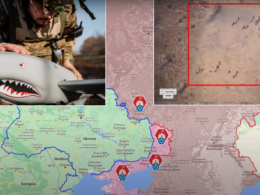18 December, 2024. Today, there is a lot of news from the Kursk direction.

Here, North Korean forces faced their first major combat test in decades, launching a large-scale assault near Kruglen’koe under ruthless Russian command. What followed was a brutal Ukrainian demonstration of modern warfare’s unforgiving nature, leaving devastating consequences for the attackers and raising serious questions about their preparedness and tactics.
Last time, we discussed how North Korean soldiers launched a large-scale assault near Kruglen’koe with blatant disregard for tactical disadvantages. This approach led to controversial outcomes and devastating losses inflicted by Ukrainian drones and artillery.

As it turned out, the result was far more catastrophic than imagined, with recently released footage revealing the grim aftermath of the failed assault. One video shows more than two dozen dead North Korean soldiers lined in the open field for transport, painting a harrowing picture of the chaos and devastation caused by modern precision warfare. North Korean troops, caught in relentless artillery barrages and targeted drone strikes, were left in disorganized heaps as they attempted to regroup at the forest’s edge.
Many of the fallen lay alongside their wounded comrades, who were given no first aid or evacuation attempts, with the lack of treatment being particularly unsettling. Footage shows that injured soldiers, often under shock, were abandoned where they fell, treated by their comrades as casualties beyond saving. Some were seen piled into crude clusters, indistinguishable from the dead, as commanders prioritized advancing their forces over providing first aid.
This brutal disregard for the wounded reflects the North Koreans’ outdated tactics, like that of the Russians, where high human cost is a calculated sacrifice.

Reports from Ukrainian soldiers on the ground confirm that the North Koreans do not provide first aid to their wounded. They described a shocking scene where an FPV drone struck a group of three soldiers, with two falling and not getting up. Despite showing signs of life, the third looked at them, stood still, and waited for others to arrive before continuing to move forward, with total disregard for the wounded.
Other reports described how shells exploded just 20 meters away from groups of soldiers, with them continuing to move at the same pace, without reaction.
The disastrous outcome of the North Korean assault near Kruglen’koe can be attributed to a combination of several key reasons. Firstly, due to time constraints and a lack of resources, North Korean troops received only rudimentary training in modern warfare. The units tasked with their instruction, the Russian VDV and marine brigades, were themselves degraded from months of heavy losses after countless unsuccessful assaults, with many experienced instructors either dead or otherwise incapacitated. This resulted in unprepared North Korean soldiers being sent into a conflict far beyond their tactical comprehension.

Secondly, further compounding the disaster, was the deliberate use of North Koreans as expendable cannon fodder by the Russian commanders. They were forced into slow, infantry-only assaults across open fields, without significant artillery or armored support. Instructed to move in lines through dense minefields, they became easy targets for Ukrainian drone surveillance and artillery fire. The bitter winter conditions only worsened their suffering, with icy terrain hindering movement and making their positions even more conspicuous.
Without proper equipment and lacking basic operational understanding, they struggled to navigate the snow and ice while under relentless attack, as seen in more published videos, reminding of the historical footage of Soviet assaults during World War Two.
One Ukrainian drone operator reported that in one instance, a North Korean group became exhausted from walking across the field under fire and sat down to rest, obviously not yet realizing what there is to fear in this unforgiving war.

Overall, the aftermath of the assault marked a catastrophic first loss for the North Koreans, who may have helped to establish a foothold but exposed their inability to adapt to contemporary warfare.
This operation, meant to bolster Russian efforts in the region, instead served as a stark reminder of the human cost of such outdated tactics, where commanders prioritize attritional gains over their soldiers’ survival. Combining this with insufficient training, an unforgiving environment, and veteran Ukrainian defenders, ensured their failure and devastating losses.
In our regular frontline report, we pair up with the military blogger Reporting from Ukraine to keep you informed about what is happening on the battlefield in the Russo-Ukrainian war.








